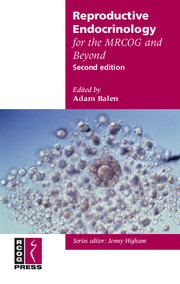Book contents
- Frontmatter
- Contents
- Acknowledgements
- Preface to the first edition
- Preface to the second edition
- Abbreviations used in this book
- 1 Sexual differentiation: intersex disorders
- 2 Adrenal disorders
- 3 Normal puberty and adolescence
- 4 Abnormal puberty
- 5 The menstrual cycle
- 6 Disorders of menstruation
- 7 Amenorrhoea
- 8 Polycystic ovary syndrome
- 9 Health consequences of polycystic ovary syndrome
- 10 Anovulatory infertility and ovulation induction
- 11 Lactation and lactational amenorrhoea
- 12 Hyperprolactinaemia
- 13 Thyroid disease
- 14 Diabetes
- 15 Lipid metabolism and lipoprotein transport
- 16 Premature ovarian failure
- 17 Calcium metabolism and its disorders
- Appendix: Endocrine normal ranges
- Further reading
- Index
1 - Sexual differentiation: intersex disorders
Published online by Cambridge University Press: 05 August 2014
- Frontmatter
- Contents
- Acknowledgements
- Preface to the first edition
- Preface to the second edition
- Abbreviations used in this book
- 1 Sexual differentiation: intersex disorders
- 2 Adrenal disorders
- 3 Normal puberty and adolescence
- 4 Abnormal puberty
- 5 The menstrual cycle
- 6 Disorders of menstruation
- 7 Amenorrhoea
- 8 Polycystic ovary syndrome
- 9 Health consequences of polycystic ovary syndrome
- 10 Anovulatory infertility and ovulation induction
- 11 Lactation and lactational amenorrhoea
- 12 Hyperprolactinaemia
- 13 Thyroid disease
- 14 Diabetes
- 15 Lipid metabolism and lipoprotein transport
- 16 Premature ovarian failure
- 17 Calcium metabolism and its disorders
- Appendix: Endocrine normal ranges
- Further reading
- Index
Summary
Development of the internal and external genitalia
The development of female internal and external genitalia is largely independent of gonadal influence whereas, in the male, the testes are essential for sexual development. During early fetal life, the pronephros, mesonephros and metanephros develop in chronological order as renal excretory organs. The mesonephros and mesonephric (wolffian) ducts form the male genital tract, while in the female these regress to nonfunctional remnants. The paramesonephric (müllerian) ducts in the female develop into the internal reproductive organs and the upper third of the vagina.
Origin of the ovaries and oocytes
Primordial follicles and oocytes are derived during fetal life and the oogonial stem cell line is lost before birth. In humans, at approximately four weeks of gestation the germ cells arise from the yolk sac and migrate along the hindgut to the genital ridge. The oogonia are able to move by pseudopodial amoeboid movements. Once the oogonia reach the genital ridge, they become associated with cortical cords and lose their motility. From weeks 5 through to 28 the oogonia undergo several mitotic divisions. At the same time, many oogonia are lost by atresia, some in their passage from the yolk sac and others once they have reached the gonad itself. Meiosis starts in approximately week nine and the life cycle of the oocyte is such that it undergoes only part of the first meiotic division entering meiotic arrest at the dictyate stage of prophase 1 (Figure 1.1).
- Type
- Chapter
- Information
- Reproductive Endocrinology for the MRCOG and Beyond , pp. 1 - 16Publisher: Cambridge University PressPrint publication year: 2007
- 1
- Cited by



